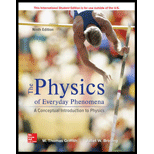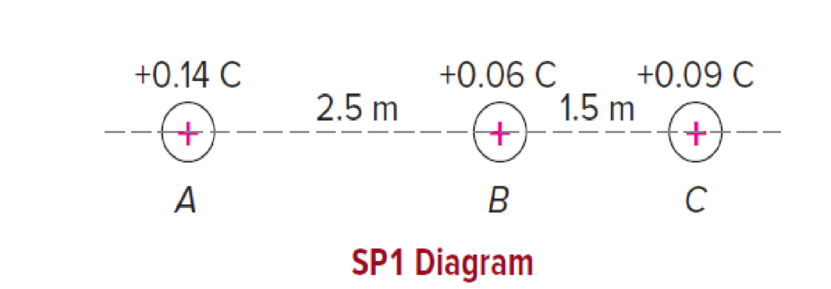
Concept explainers
Three positive charges are located along a line, as in the diagram. The 0.14 C charge at points A is 2.5 m to the left of the 0.06 C charge at point B, and the 0.09 C charge at point C is 1.5 m to the right of point B.
a. What is the magnitude of the force exerted on the 0.06 C charge by the 0.14 C charge?
b. What is the magnitude of the force exerted on the 0.06 C charge by the 0.09 C charge?
c. What is the net force exerted on the 0.06 C charge by the other two charges?
d. If we regard the 0.06 C charge as a test charge used to probe the strength of the electric field produced by the other two charges, what are the magnitude and direction of the electric field at point B?
e. If the 0.06 C charge at point B is replaced by a –0.17 C charge, what are the magnitude and direction of the electrostatic force exerted on this new charge? (Use the electric field value to find this force.)

(a)
The magnitude of the force on
Answer to Problem 1SP
The magnitude of the force on
Explanation of Solution
Given Info: The distance between the charges at A and B is
The diagram showing the charges

Write the expression to find the electrostatic force.
Here,
Substitute
Conclusion:
The magnitude of the force on
(b)
The magnitude of the force on
Answer to Problem 1SP
The magnitude of the force on
Explanation of Solution
Given Info: The distance between the charges at C and B is
The diagram showing the charges

Write the expression to find the electrostatic force.
Here,
Substitute
Conclusion:
The magnitude of the force on
(c)
The net force exerted on the
Answer to Problem 1SP
The net force exerted on the
Explanation of Solution
Given Info: The magnitude of the force on
The diagram showing the charges

Write the expression to find the net electrostatic force on charge at B.
Here,
F is the net electrostatic force on charge at B
Consider the right direction to be positive.
Substitute
Since, the net force is negative; the direction of the net force will be in the left direction.
Conclusion:
The net force exerted on the
(d)
The direction and magnitude of the electric field at the point B.
Answer to Problem 1SP
The direction and magnitude of the electric field at point B is
Explanation of Solution
Given Info: The net force exerted on the
The diagram showing the charges

Write the expression to find the electric field.
Here,
q is the charge
Substitute
The direction of the electric field is in the left direction.
Conclusion:
The direction and magnitude of the electric field at point B is
(e)
The direction and magnitude of the electrostatic force exerted on the new charge if the
Answer to Problem 1SP
The direction and magnitude of the electrostatic force exerted on the new charge if the
Explanation of Solution
Given Info: The direction and magnitude of the electric field at point B is
The diagram showing the charges

Write the expression to find the electrostatic force.
Here,
q is the charge
Substitute
The direction of the electrostatic force will be in the right direction.
Conclusion:
The direction and magnitude of the electrostatic force exerted on the new charge if the
Want to see more full solutions like this?
Chapter 12 Solutions
Physics of Everyday Phenomena
- Review. Two insulating spheres have radii 0.300 cm and 0.500 cm, masses 0.100 kg and 0.700 kg, and uniformly distributed charges 2.00 C and 3.00 C. They are released from rest when their centers are separated by 1.00 m. (a) How fast will each be moving when they collide? (b) What If? It the spheres were conductors, would the speeds be greater or less than those calculated in part (a)? Explain.arrow_forwardIntegrated Concepts An electron has an initial velocity of 5.00106m/s in a uniform 2.00105N/C strength electric field. the field accelerates the electron in the direction opposite to its initial velocity. (a) What is the direction of the electric field? (b) How far does the electron travel before coming to rest? (c) How long does it take the electron to come to rest? (d) What is the electron’s velocity when it returns to its starting point?arrow_forwardA simple and common technique for accelerating electrons is shown in Figure 18.55, where there is a uniform electric field between two plates. Electrons are released, usually from a hot filament, near the negative plate, and there is a small hole in the positive plate that allows the electrons to continue moving. (a) Calculate the acceleration of the electorn if the field strength is 2.50104 N/C. (b) Explain why the electron will not be pulled back to the positive plate once it moves through the hole.arrow_forward
- A person is placed in a large, hollow, metallic sphere that is insulated from ground, (a) If a large charge is placed on the sphere, will the person be harmed upon touching the inside of the sphere? (b) Explain what will happen if the person also has an initial charge whose sign is opposite that of the charge on the sphere.arrow_forward(a) Two point charges q1 and q23.00 m apart, and their total charge is 20 C. (a) If the force of repulsion between them is 0.075N, what are magnitudes of the two charges? (b) If one charge attracts the other with a force of 0.150 N, what are the magnitudes of the two charges? Note that you may need to solve a quadratic equation to reach your answer.arrow_forwardA proton and an alpha particle (charge = 2e, mass = 6.64 1027 kg) are initially at rest, separated by 4.00 1015 m. (a) If they are both released simultaneously, explain why you cant find their velocities at infinity using only conservation of energy. (b) What other conservation law can be applied in this case? (c) Find the speeds of the proton and alpha particle, respectively, at infinity.arrow_forward
- Review. From a large distance away, a particle of mass m1, and positive charge q1 is fired at speed in the positive x direction straight toward a second particle, originally stationary but free to move, with mass m2, and positive charge q2. Both particles are constrained to move only along the x axis. (a) At the instant of closest approach, both particles will be moving at the same velocity. Find this velocity, (b) Find the distance of closest approach. After the interaction, the particles will move far apart again. At this time, find the velocity of (c) the particle of mass m1, and (d) the particle of mass m2.arrow_forwardEarth has a net charge that produces an electric field of approximately 150 N/C downward at its surface. (a) What is the magnitude and sign of the excess charge, noting the electric field of a conducting sphere is equivalent to a point charge at its center? (b) What acceleration will the field produce on a free electron near Earth’s surface? (c) What mass object with a single extra electron will have its weight supported by this field?arrow_forward(a) Would life be different if the electron were positively charged and the proton were negatively charged? (b) Does the choice of signs have any bearing on physical and chemical interactions? Explain your answers.arrow_forward
- (a) By what factor must you change the distance between two point charges to change the force between them by a factor of 10? (b) Explain how the distance can either increase or decrease by this factor and still cause a factor of 10 change in the forcearrow_forward(a) What is the electric field 5.00 m from the center of the terminal of a Van de Graaff with a 3.00 mC charge, noting that the field is equivalent to that of a point charge at the center of the terminal? (b) At this distance, what force does the field exert on a 2.00 C charge on the Van de Graaff’s belt?arrow_forward(a) How strong is the attractive force between a glass rod with a 0.700 C charge and a silk cloth with a 0.600 C charge, which are 12.0 cm apart, using the approximation that they act like point charges? (b) Discuss how the answer to this problem might be affected if the charges are distributed over some area and do not act like point charges.arrow_forward
 Physics for Scientists and Engineers with Modern ...PhysicsISBN:9781337553292Author:Raymond A. Serway, John W. JewettPublisher:Cengage Learning
Physics for Scientists and Engineers with Modern ...PhysicsISBN:9781337553292Author:Raymond A. Serway, John W. JewettPublisher:Cengage Learning Physics for Scientists and EngineersPhysicsISBN:9781337553278Author:Raymond A. Serway, John W. JewettPublisher:Cengage Learning
Physics for Scientists and EngineersPhysicsISBN:9781337553278Author:Raymond A. Serway, John W. JewettPublisher:Cengage Learning Physics for Scientists and Engineers, Technology ...PhysicsISBN:9781305116399Author:Raymond A. Serway, John W. JewettPublisher:Cengage Learning
Physics for Scientists and Engineers, Technology ...PhysicsISBN:9781305116399Author:Raymond A. Serway, John W. JewettPublisher:Cengage Learning College PhysicsPhysicsISBN:9781938168000Author:Paul Peter Urone, Roger HinrichsPublisher:OpenStax College
College PhysicsPhysicsISBN:9781938168000Author:Paul Peter Urone, Roger HinrichsPublisher:OpenStax College Principles of Physics: A Calculus-Based TextPhysicsISBN:9781133104261Author:Raymond A. Serway, John W. JewettPublisher:Cengage Learning
Principles of Physics: A Calculus-Based TextPhysicsISBN:9781133104261Author:Raymond A. Serway, John W. JewettPublisher:Cengage Learning College PhysicsPhysicsISBN:9781305952300Author:Raymond A. Serway, Chris VuillePublisher:Cengage Learning
College PhysicsPhysicsISBN:9781305952300Author:Raymond A. Serway, Chris VuillePublisher:Cengage Learning





